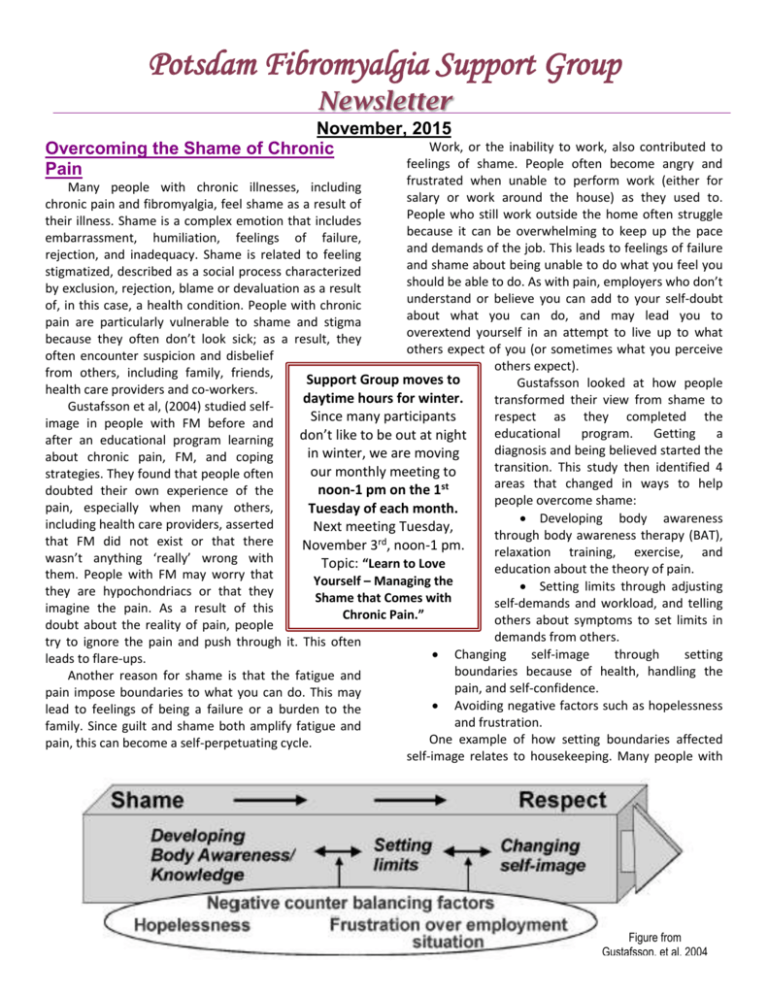November, 2015 - Clarkson University
advertisement

Potsdam Fibromyalgia Support Group Newsletter November, 2015 Work, or the inability to work, also contributed to Overcoming the Shame of Chronic feelings of shame. People often become angry and Pain frustrated when unable to perform work (either for Many people with chronic illnesses, including salary or work around the house) as they used to. chronic pain and fibromyalgia, feel shame as a result of People who still work outside the home often struggle their illness. Shame is a complex emotion that includes because it can be overwhelming to keep up the pace embarrassment, humiliation, feelings of failure, and demands of the job. This leads to feelings of failure rejection, and inadequacy. Shame is related to feeling and shame about being unable to do what you feel you stigmatized, described as a social process characterized should be able to do. As with pain, employers who don’t by exclusion, rejection, blame or devaluation as a result understand or believe you can add to your self-doubt of, in this case, a health condition. People with chronic about what you can do, and may lead you to pain are particularly vulnerable to shame and stigma overextend yourself in an attempt to live up to what because they often don’t look sick; as a result, they others expect of you (or sometimes what you perceive often encounter suspicion and disbelief others expect). from others, including family, friends, Support Group moves to Gustafsson looked at how people health care providers and co-workers. daytime hours for winter. transformed their view from shame to Gustafsson et al, (2004) studied selfrespect as they completed the Since many participants image in people with FM before and educational program. Getting a don’t like to be out at night after an educational program learning diagnosis and being believed started the in winter, we are moving about chronic pain, FM, and coping transition. This study then identified 4 our monthly meeting to strategies. They found that people often areas that changed in ways to help noon-1 pm on the 1st doubted their own experience of the people overcome shame: pain, especially when many others, Tuesday of each month. Developing body awareness including health care providers, asserted Next meeting Tuesday, through body awareness therapy (BAT), that FM did not exist or that there November 3rd, noon-1 pm. relaxation training, exercise, and wasn’t anything ‘really’ wrong with Topic: “Learn to Love education about the theory of pain. them. People with FM may worry that Yourself – Managing the Setting limits through adjusting they are hypochondriacs or that they Shame that Comes with self-demands and workload, and telling imagine the pain. As a result of this Chronic Pain.” others about symptoms to set limits in doubt about the reality of pain, people demands from others. try to ignore the pain and push through it. This often Changing self-image through setting leads to flare-ups. boundaries because of health, handling the Another reason for shame is that the fatigue and pain, and self-confidence. pain impose boundaries to what you can do. This may Avoiding negative factors such as hopelessness lead to feelings of being a failure or a burden to the and frustration. family. Since guilt and shame both amplify fatigue and One example of how setting boundaries affected pain, this can become a self-perpetuating cycle. self-image relates to housekeeping. Many people with Figure from Gustafsson, et al, 2004 FM are women who have a “housekeeper identity” where a lot of effort had been put into keeping the house tidy and organized to satisfy other people’s needs. After the educational program, participants adopted new strategies such as reducing their own expectations, asking for help, planning and pacing, and using body awareness. One participant in that study said “I can leave the dust and do something fun instead, well, maybe not always, but sometimes.” One explanation Gustafsson gave for the transition from shame to respect was that self-image improved as people learned about their condition, how pain is processed in the body and brain, and what they could do to take care of themselves. This improved selfimage, in turn, resulted in more respect and understanding from family, friends, health-care workers and co-workers. Another explanation for the transition was moving from a biomedical to a biopsychosocial model of pain. In the biomedical model, mind and body are separate and the body is a machine that should operate properly and, whether the body functions or not is independent of the mind. In the biopsychosocial model, mind, body, and social context are all inter-related. Knowledge, body awareness and relaxation can make the symptoms more understandable and provide more control. Another study, by van der Beek et al, (2013) looked at the impact of stigma on quality of life among people with chronic neurological diseases. They distinguished self-stigma from ‘enacted stigma’ (objective evidence that others treated them differently) to be able to contrast effects from each. They found that both self and enacted stigma were associated with lower physical, psychological and social quality of life. However, self-stigma had a stronger effect on quality of life independent of other variables related to people’s life or actual limitations imposed by the health condition. Translated, this means that the shame associated with having a chronic disease can compromise quality of life (physical, psychological and social) more than the actual limitations imposed by the disease. So, what can we do about the shame we feel due to our chronic illness? An article by Wren, et al (2012) looked at self-compassion in people with chronic pain. They identify 3 components to self-compassion: Self-kindness vs. self-judgment Common humanity vs. isolation Mindfulness vs. over-identification. According to this study, “self-kindness refers to the ability to be caring and supportive to oneself when dealing with a difficult aspect of one’s personality or life circumstance and avoiding being overly self-critical.” They describe common humanity as “recognizing that one’s difficulties are universal and part of a larger human experience.” And “the quality of mindfulness refers to the ability to be in the present moment with one’s experiences, so as not to ignore or overidentify with difficult thoughts or feelings.” The study by Wren, et al, found that people with more self-compassion had less negative affect and catastrophizing, less pain disability, and more positive feelings and self-efficacy. These results are important because previous research has shown that positive affect is associated with more effective pain coping and function. Although they did not specifically study shame, it would make sense that increased selfcompassion would be associated with decreased feelings of shame. Resources used: Gustafsson M, Ekholm J, Ohman A. From shame to respect: musculoskeletal pain patients’ experience of a rehabilitation programme, a qualitative study. J Rehabil Med. 2004;36:97-103. Van der Beek K, Bos I, Middel B, Wynia K. Experienced stigmatization reduced quality of life of patients with a neuromuscular disease: a cross-sectional study. Clin Rehab. 2013;27(11):1029-1038. Wren AA, Somers TJ, et al. Self-compassion in patients with persistent musculoskeletal pain: relationship of self-compassion to adjustment to persistent pain. J Pain Symptom Manage. 2012;43(4):759-70. Tuesday, November 3rd Fibromyalgia Support Group Meeting: The Potsdam Fibromyalgia Support Group will meet Tuesday, November 3rd, noon-1 pm. Topic: “Learn to Love Yourself – Managing the Shame that Comes with Chronic Pain.” People with chronic pain often feel guilt for what they cannot do, and shame for who they are. This is especially true for an ‘invisible’ condition like fibromyalgia, where people often say “but you look so good!” This guided discussion will provide a forum for people to discuss their feelings of shame or embarrassment at having a chronic illness, and explore opportunities to create a more positive selfimage…indeed, to “Learn to Love Yourself.” This newsletter is a joint effort of Clarkson University and CantonPotsdam Hospital. If you would prefer to receive these newsletters electronically, please send your email address to lnrussek@clarkson.edu. You can access current and previous Potsdam Fibromyalgia Support Group Newsletters on our web site: www.people.clarkson.edu/~lnrussek/FMSG.




